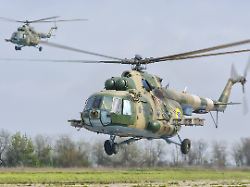“Flying low is the goal”
How Kiev’s attack helicopters defend Bakhmut
03/12/2023, 8:25 p.m
The Ukrainian armed forces are almost encircled in Bakhmut, but are not giving up their positions. To keep the Russians in check, helicopter pilots fly dangerous combat missions with outdated equipment every day. They owe their accuracy to small aircraft.
Three Mi-8 attack helicopters take off from a secret base in Ukraine and head towards their destination near the town of Bakhmut. As the helicopters close in on the target, they suddenly right themselves, fire their missiles and fly back to base. The goal is “on an enemy line of fortifications consisting of ground troops, armored vehicles and an ammunition depot,” says Petro, one of the pilots, after the approximately 30-minute mission. He was deployed near Sieverodonetsk, a town northeast of Bakhmut captured by the Russian army last spring. In Bakhmut, the Ukrainian forces are now almost surrounded, but with heavy casualties on both sides, they are holding out.
Since the beginning of the Russian invasion a little over a year ago, Ukrainian helicopter pilots have been flying dangerous missions in their old Mi-8 and Mi-24 helicopters on a daily basis. Pilot Petro has already flown around 50 combat missions at the age of 23. “Before the flight, we choose the flight route using special apps,” he says. “For example, if we see heights of 180 meters, then that’s too high, so we look for places that are lower.” The goal is to fly low “so as not to be visible on Russian radars and they don’t know we’re coming,” says Petro, whose hoodie covers his entire face except for his eyes. “When we are 6200 meters from the target, we straighten up by 20 degrees (…), then we fire the missiles, 15 on each side.” Then the helicopter with a pilot and a co-pilot on board makes its way back at low altitude. The route is different from the outward flight – “so as not to fall into a trap” and be attacked by Russian air defenses, as Petro says.
Helicopters too old – drones help with accuracy
On the front line, infantry units, previously informed of the timing of the attack, launch a drone. They use this to check whether the target of the attack has been achieved. If the target was not hit, corrections are made for another shot. The outdated weapon system of the helicopters is not equipped with either a guidance or an aiming system. Therefore, it is only accurate to within 100 to 200 meters. “At the beginning of the war we didn’t have any drones. The missions were more complicated and less effective,” says Petro. From the summer, however, they would have received drones and other equipment. “Today we are more effective.”
Petro’s most difficult mission to date took place on March 6 last year in the southern Ukrainian region of Mykolaiv. “We were four helicopters and the target was a long convoy of military vehicles” that would have been on the way to the Zaporizhia nuclear power plant, which is now occupied by Russia. “We saw the target from about two kilometers away. We were told that it wasn’t moving, but it was actually moving,” recalls Petro. The Ukrainians were shot at. “Two of our helicopters were destroyed, the third was damaged and I was lucky to be in the fourth. I wasn’t hit.”
“As soon as the engine starts, the fear disappears”
For the 23-year-old, “the most difficult thing is the preparation, the decision-making, how to behave during the flight, in which direction to fly to the destination, because you don’t know the landscape before the flight, you can’t be sure about anything “, he explains. But he is not afraid of an attack. “As soon as you start the engine, the fear disappears because that’s what we were trained for, we have confidence in ourselves and our decisions.”
There are many videos of Ukrainian helicopter operations in online media, the pilots are often celebrated as heroes. But Petro thinks of the soldiers who “suffer much more than we do, even if they greet and support us from the ground”. “They are always in position. Even if we take a lot of risks, we don’t need a lot of time to complete a mission,” says Petro. “When I see the guys on the ground supporting us, I know exactly why I’m here.”
